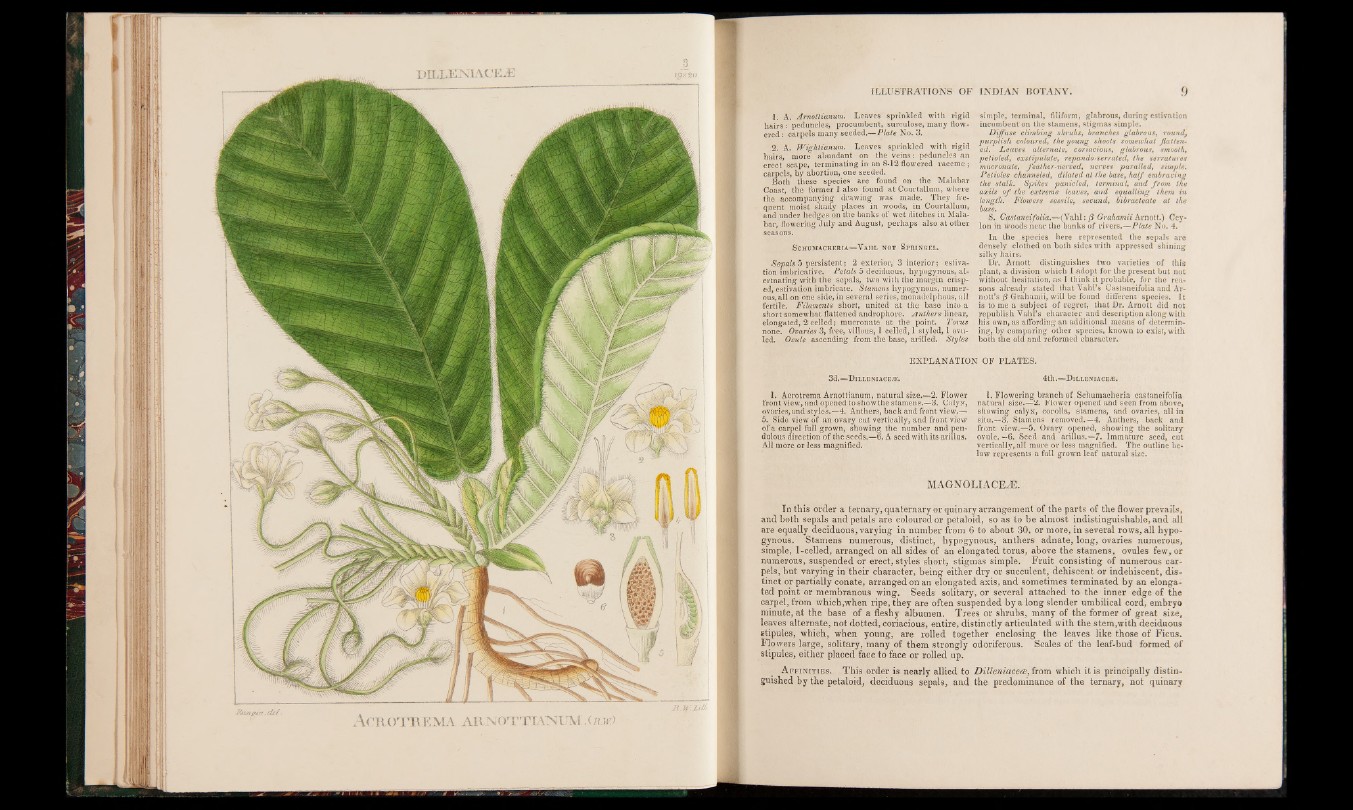
fir
d r l e n i a c e æ
t.dU . ACROTREMA ARNOTTIANUM S r .w)
1. A. Arnottianum. Leaves sprinkled with rigid
hairs: peduncles, procumbent, sureulose, many flowered:
carpels many seeded.— Plate No. 3.
2. A. Wigklvanum. Leaves sprinkled with rigid
hairs, more abundant on the veins: peduncles an
erect scape, terminating in an 8-12 flowered raceme;
carpels, by abortion, one seeded.
Both these species are found on the Malabar
Coast, the former I also found at Courtallum, where
the accompanying drawing was made. They frequent
moist shady places in woods, in Courtallum,
and under hedges on the banks of wet ditches in Malabar,
flowering July and August, perhaps also at other
seasons.
ScHUMACHERIA— VAHL NOT SPRINGEL.
Sepals 5 persistent; 2 exterior, 3 interior; estivation
imbricative. Petals 5 deciduous, hypogynous, al-
ertnating with the sepals, two with the margin crisped,
estivation imbricate. Stamens hypogynous, numerous,
all on one side, in several series, monadelphous, all
fertile. Filaments short, united at the base into a
short somewhat flattened androphore. Anthers linear,
elongated, 2 celled; mucronate at the point. Torus
none. Ovaries 3, free, villous, I celled, 1 styled, 1 ovu-
led. Ovule ascending from the base, arilled. Styles
simple, terminal, filiform, glabrous, during estivation
incumbent on the stamens, stigmas simple.
Diffuse climbing shrubs, branches glabrous, rounds
purplish coloured, the young shoots somewhat flattened.
Leaves alternate, coriacious, glabrous, smooth,
petioled, exstipulate, repando -serrated, the serralures
mucronate, feather-nerved, nerves paralled, simple.
Petioles channeled, dilated at the base, h a lf embracing
the stalk. Spikes panicled, terminal, and fr om the
axils o f the extreme leaves, and equalling them in
length. Flowers sessile, secund, bibracteale at the
base.
S. Castaneifolia.—(Vahl: ft Grahamii Arabic.) Ceylon
in woods near the banks of rivers.—Plate No. 4.
In the species here represented the sepals are
densely clothed on both sides with appressed shining
silky hairs.
Dr. Arnott distinguishes two varieties o f this
plant, a division which I adopt for the present but not
without hesitation, as I think it probable, for the reasons
already stated that Vahl’s Castaneifolia and Arnott’s
ft Grahamii, will be found different species. It
is to me a subject of regret, that Dr. Arnott did not
republish Vahl’s character and description along with
his own, as affording an additional means of determining,
by comparing other species, known to exist, with
both the old and reformed character.
EXPLANATION OF PLATES.
3d.—DlLLENIACEiE.
1. Acrotrema Arnottianum, natural size.—2. Flower
front view, and opened to show the stamens.—3. Calyx,
ovaries, and styles.—4. Anthers, back and front view.—
5. Side view of an ovary cut vertically, and front view
of a carpel full grown, showing the number and pendulous
direction of the seeds.—6. A seed with its arillus.
All more or less magnified.
4th.—Dilleniaceje.
1. Flowering branch of Schumacheria castaneifolia
natural size.—2. Flower opened and seen from above,
showing calyx, corolla, stamens, and ovaries, all in
situ.—3. Stamens removed.—4. Anthers, back and
front view.—5. Ovary opened, showing the solitary
ovule. —6. Seed and arillus.—7. Immature seed, cut
vertically, all more or less magnified. The outline below
represents a full grown leaf natural size.
MAGNOLIACEA3.
In this order a ternary, quaternary or quinary arrangement of the parts of the flower prevails,
and both sepals and petals are coloured or petaloid, so as to be almost indistinguishable, and all
are equally deciduous, varying in number from 6 to about 30, or more, in several rows, all hypogynous.
Stamens numerous, distinct, hypogynous, anthers adnate, long, ovaries numerous,
simple, 1-celled, arranged on all sides of an elongated torus, above the stamens, ovules few, or
numerous, suspended or erect, styles short, stigmas simple. Fruit consisting of numerous carpels,
but varying in their character, being either dry or succulent, dehiscent or indehiscent, distinct
or partially conate, arranged on an elongated axis, and sometimes terminated by an elongated
point or membranous wing. Seeds solitary, or several attached to the inner edge of the
carpel, from which,when ripe, they are often suspended by a long slender umbilical cord, embryo
minute, at the base of a fleshy albumen. Trees or shrubs, many of the former of great size,
leaves alternate, not dotted, coriacious, entire, distinctly articulated with the stem,with deciduous
stipules, which, when young, are rolled together enclosing the leaves like those of Ficus.
Flowers large, solitary, many of them strongly odoriferous. Scales of the leaf-bud formed of
stipules, either placed face to face or rolled up.
A ffinities. This order is nearly allied to Dilleniacece,ivom which it is principally distinguished
by the petaloid, deciduous sepals, and the predominance of the ternary, not quinary